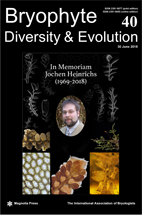Abstract
The pleurocarpous moss genus Hypnum s.l. is a species-rich (> 40 species) cosmopolitan genus, of which 21 taxa occur in Europe. Although several of these species show high morphological resemblance there are strong indications that the genus is highly paraphyletic, which may be masked by convergent morphological evolution. Using molecular information, we analyse whether the morphological similarity of gametophytes of the European Hypnum taxa is explained by common ancestry or convergence. We provide a phylogenetic reconstruction of the relationships of the currently recognized European Hypnum taxa in a broad pleurocarpous moss context (192 taxa) using the nuclear ITS1-5.8S-ITS2, the plastid rps4 gene and trnL-F, and the mitochondrial nad5 intron. Bayesian tree topologies show that the genus is polyphyletic, and we retain only the Hypnum cupressiforme complex within Hypnum. The genus originally represented half of the moss species diversity, as it accommodated basically all pleurocarpous mosses; here we retain only seven species and one variety. The remainder of the species where resolved either within the three families Amblystegiaceae, Entodontaceae, and Pylaisiaceae, or in an independent clade that we describe as the new family Stereodontaceae. The Stereodontaceae includes five European species, all in the genus Stereodon, where they were already placed in the 18th century. In addition, we describe the four new genera Aquilonium, Insomniella, Jochenia, and Lignocariosa, and make new combinations for several Hypnum species.

